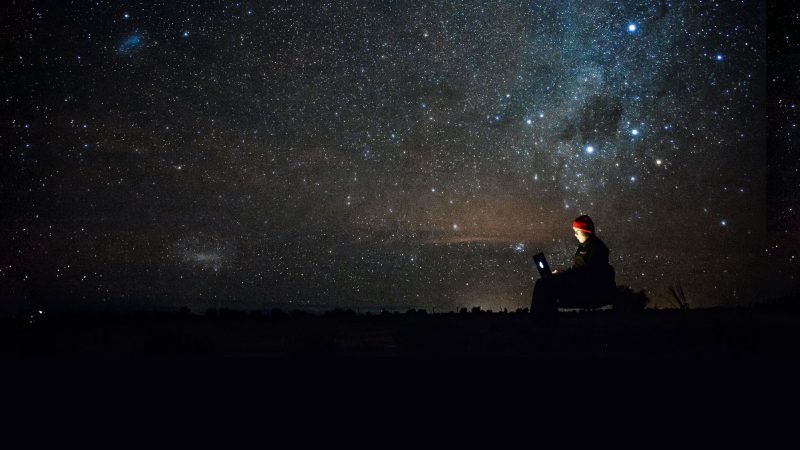Elon Musk is famous for many things. He founded X.com, which later became PayPal, SpaceX, and Tesla Motors. He recently became the wealthiest person in the world.
So when Americans hear about his latest satellite internet endeavor called Starlink, we want to jump on board. We want so badly for it to succeed so we can escape data caps, cell tower congestion, and outrageous broadband internet monthly bills.
But is Starlink really the answer? Let’s take a look at five reasons to avoid Starlink internet — for now.

What Is Starlink?
Starlink is a satellite internet service provided by SpaceX. Although still in testing and not widely available to the public, Starlink promises 100Mbps download and 20Mbps upload speeds.
It’s far more advanced than other satellite internet services. One reason is the satellites are much closer to Earth at only 300-500 miles.
However, again, it’s not ready for mass consumption yet. It still has to figure out some quirks and launch more satellites to offer additional coverage. Currently, only a small portion of the population has access to Starlink.

5 Reasons You Should Avoid Starlink Internet
Even with all of the promises Starlink has made, it’s not there yet. Don’t go putting all of your eggs in this basket.
It’s expensive, energy inefficient, and inconsistent. Because it’s a satellite-based system, any obstacles like trees or buildings will interrupt the signal.
Right now, just avoid Starlink. Maybe it’s the future answer, but it’s not a present solution. Let’s see five reasons why.
#1 It’s Expensive
The start-up cost is $499. Then the monthly fee is $99. Most people would be willing to pay this, especially RVers, boaters, and residents of rural communities. But when it fails or service is interrupted, the benefits don’t outweigh the frustrations. It’s an expensive concept without much proof of effectiveness.
#2 It Can Use a Lot of Power
If you boondock often, this will be a problem. Stalink’s dish uses about 100 watts of power while in use. This is more than 10-20 times the power required for staying connected over a router. The company has said that it’s working on reducing its power consumption. But time will tell.
Right now, if you’re relying on solar power for energy, you’ll need several lithium batteries and multiple solar panels if you want to run your Starlink internet for any length of time. If you work remotely and need the internet for eight to 10 hours per day, Starlink will use a hefty chunk of your energy.

#3 You Need a Very Clear Line of Sight
This is one of the biggest reasons to avoid Starlink. You have to have a clear line of sight. No trees, no buildings, no chimneys — nothing can be in the way of the line of sight to the satellite.
Just adding more satellites won’t completely fix this problem. RVers who travel to national forests need the internet to work while they’re sitting under tree cover. Unless you live on a boat in the middle of the ocean or on a farm without a tree in sight, you’re going to struggle to receive quality signals.
#4 It’s Inconsistent
It’s inconsistent because of the clear line of sight issues. It’s also inconsistent because there aren’t enough satellites orbiting the Earth yet. The gaps between satellites cause outages.
As the company launches more satellites, it might resolve this problem. But that still leaves the clear line of sight problems.

#5 It Could End Up Just as Regulated as Any Other Service
The Federal Communications Commission (FCC) regulates broadband on the ground. Launching satellites into the sky to build a different network sounds like a great answer. But we don’t know the future. Starlink could very well still end up being regulated just like other broadband internet providers.
The FCC “is the United States’ primary authority for communications law, regulation and technological innovation.” It handles the “economic opportunities and challenges associated with rapidly evolving advances in global communications.” Starlink may very well end up falling under the umbrella of the FCC’s authority.
Alternatives to Starlink Internet
The best alternatives to Starlink are data plans offered by providers like Verizon, T-Mobile, and AT&T. Although there are data caps and throttling, these providers offer the most reliable internet. Whether it’s through hotspots or cell phones, your best bet as a traveler is to stick with these providers for now.
Using public Wi-Fi is another option. Some campgrounds, coffee shops, grocery stores, libraries, and other public locations offer free Wi-Fi. If you can take your work to these locations, it’s a more reliable option than Starlink. Plus, it’s free.
Is Starlink Internet Worth It?
Currently, Starlink isn’t worth a penny. It’s certainly not worth $499. In the future, could Starlink be the answer for travelers and digital nomads? Absolutely.
But with the latency issues and unreliable connections, the only part of Starlink that’s consistent right now is the inconsistency. If you’re jumping on the Starlink bandwagon, hold your horses. Give it some time.
How long do you think it will take Starlink to be widely accessible and reliable across the country?
If You Want the Latest Travel News, Join Our Mailing List
Don’t rely on biased RV industry news sources to keep you informed. Stick with Nomadic News. We publish articles and breaking stories that matter to you every weekday.










